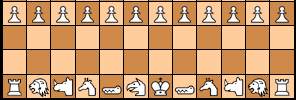[ List Latest Comments Only For Pages | Games | Rated Pages | Rated Games | Subjects of Discussion ]
Comments/Ratings for a Single Item
Escribed about old-fashioned 8x8 are the Templar Chess squares to fit the one unorthodox piece, the Querquisite. We know the files of R, N, B, Q, and K, and whatever file the Querquisite is in, is how they move. Not left to domain of problemists now, like for example most hoppers remain (see Jeliss), Querquisite gets first CV use in artwork here by Sibahi. Querquisite in h-file is Rook, g-file Knight, and so on. Invented in 1947 by Creed, later cousins are Abbott's Chameleon(1962) and Havel's Jester(1999), as Abdul-Rahman's follow-up paragraphs explain under variations. I pictured Sibahi finding old magazines in libraries, as I had to do in 1992 with British Chess Magazines for old T.R. Dawson material. However, it turns out there is link he shows here on Internet to FCR June 1947 through Variant Chess article 1998 by Emmerson.
The values of Rook+Bishop, Rook+Knight, Bishop+Knight are not simply the sum of their components. The Bishop (on a rectilinear board) can make its move from squares of only one colour, and the Queen, for example, can make that move from either colour.
I tried to calculate rough estimates for the values of the pieces, using the Safe Check principle. This is, simply put, if you place a piece and a King randomly on the board, the probability of that piece giving a 'safe check' to the King. For pieces like the Knight this like the movement estimation.
[[ The following calculations assume that the Querquisite on the e-file moves like a King, but the one on the D-file moves like a Queen. Any changes in the definitions of files (as in Fischer Random) might change the value of the Querquisite. ]]
I came out with these percentages :
R= 15.7 %
B= 8.7 %
N= 7.9 %
U= 10.8 %
And the Queen is simply the sum of its components. So are the Chancellor (Rook+Knight) and Archbishop (Bishop+Knight.) The Querquisite's compounds are a waste of time to calculate, since they're not practical.
Giving the Knight the absolute value of 3 Pawns, these are the values:
N= 3 Pawns
B= 3.3 Pawns
R= 6 Pawns (However, as in normal Chess, I think they should be
adjusted to 5 Pawns.)
Q= 9.4 Pawns
U= 4 Pawns
Out of curiosity, I computed the two Capablanca pieces on this board:
A= 6.3 Pawns
C= 9.4 Pawns
This seems about right. It's worth mentioning that the values would certainly change on a 10x8 board with these two Half-Ranks added.
The Querquisite, generally, is most mobile on the Rooks and Queen's files. Place it there.4 comments displayed
Permalink to the exact comments currently displayed.
